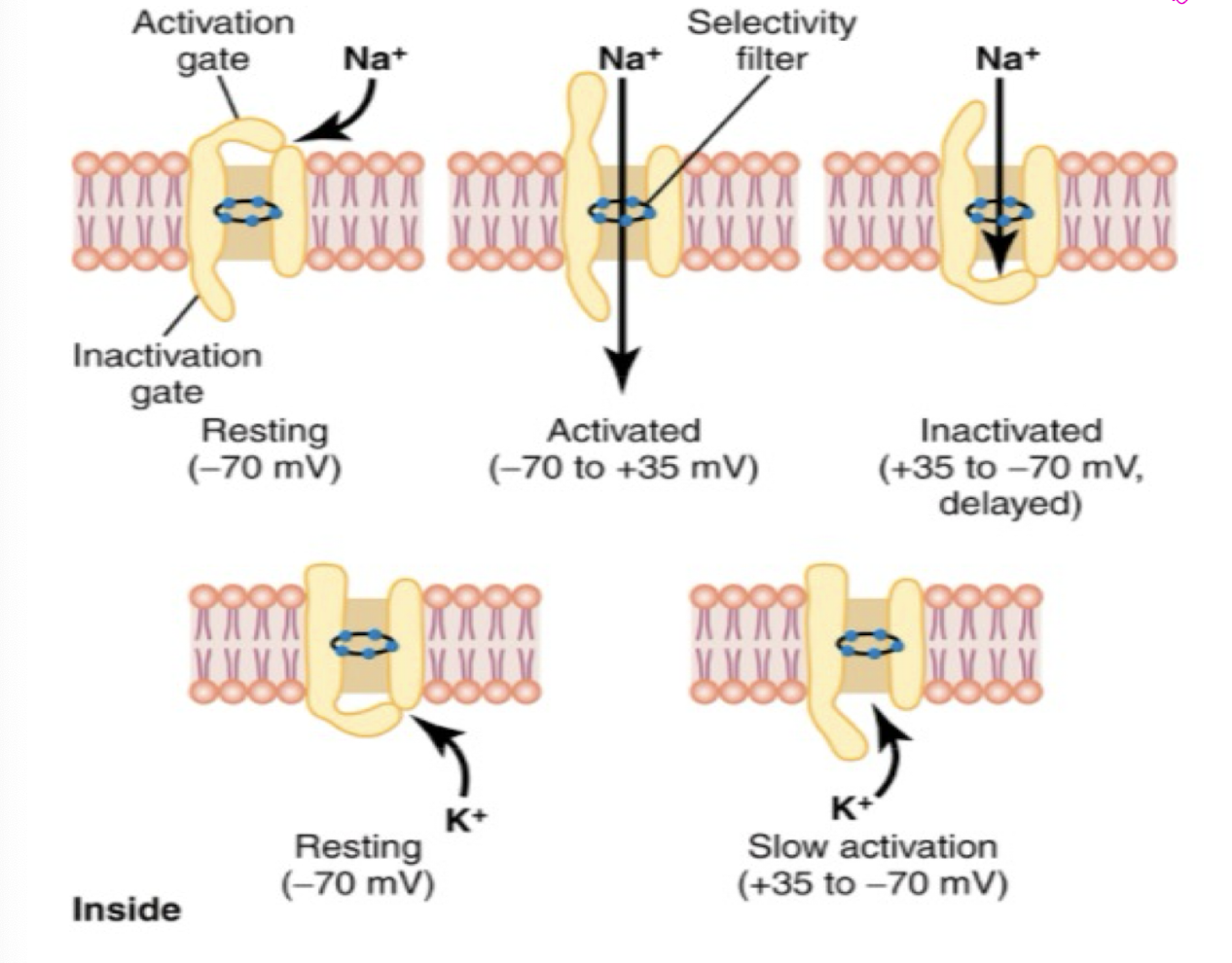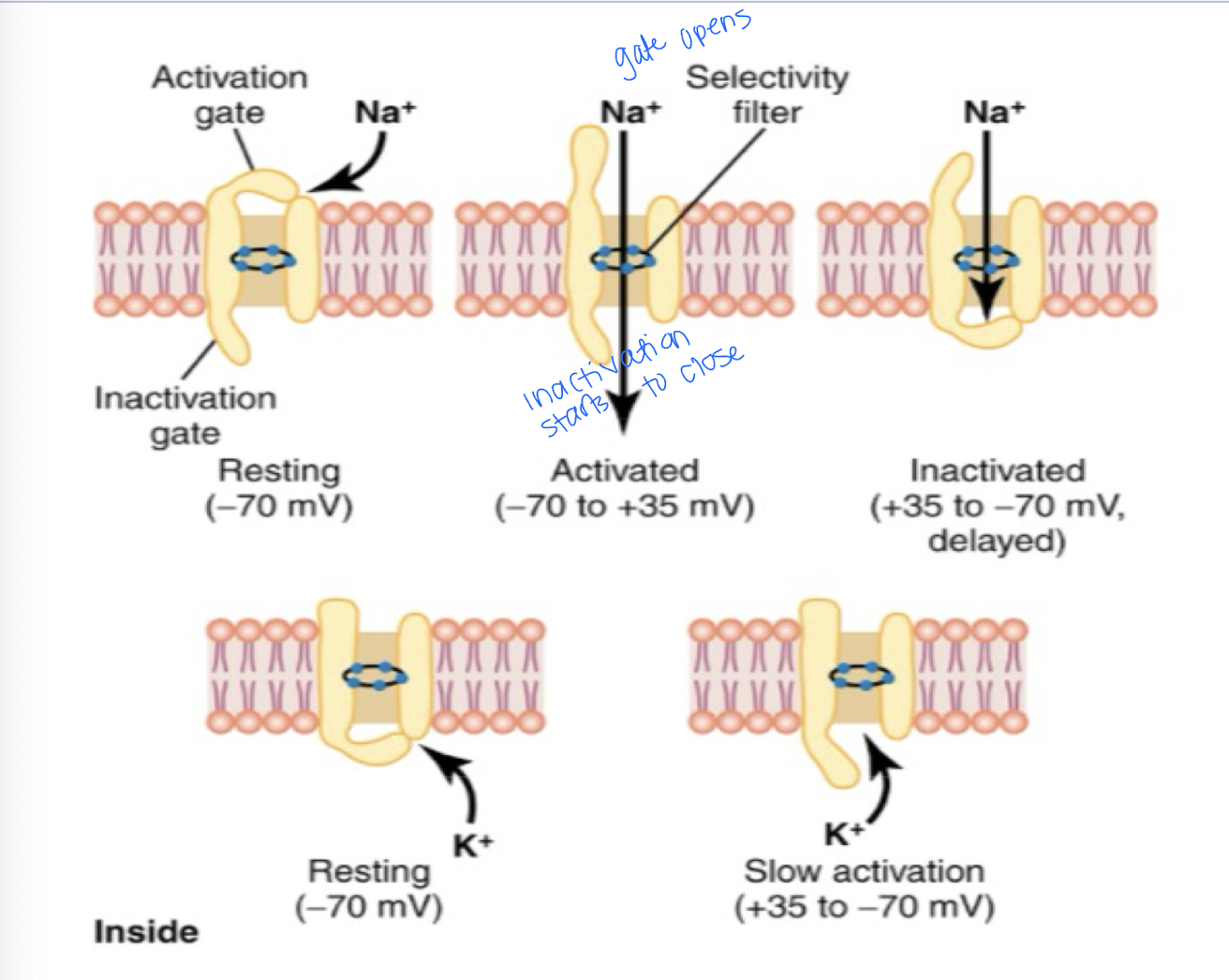Ch. 5 Membrane Potentials and Action Potentials
1/31
Earn XP
Description and Tags
Flashcards about membrane potentials and action potentials.
Name | Mastery | Learn | Test | Matching | Spaced |
|---|
No study sessions yet.
32 Terms
What creates a membrane potential?
Due to concentration gradient of selectively permeable substances across the membrane.
Define diffusion potential/membrane potential
Electrical difference between inside and outside of cell due to concentration gradient.
What is the Nernst potential?
The diffusion potential across a membrane that exactly opposes the net diffusion of a particular ion through the membrane.
What three factors does diffusion potential depend on when the membrane is permeable to several ions?
Polarity of electrical charge of each ion
permeability of membrane to each ion
concentrations of respective ions.
What is the typical resting membrane potential (RMP) of some nerve fibers?
Name a process responsible for this.
-90 mV
Na+/K+ pump
Na+/K+ leak channel is responsible for establishing the RMP
When K+ has high volumes in the cell, cell is at -94 mV. However, when Na+ begins to enter the cell, the positive ions create a charge of -86 mV. the Na+k+ pump will level the concentration in the cell allowing it to reach -90 mV reaching RMP
What is the nerve action potential (AP)?
Rapid changes in the membrane potential that spreads rapidly along the nerve fiber membrane (in skeletal muscle)
Each AP begins with sudden change from normal RMP to positive potential (resting to depolarization) and then rapidly equal change back to negative potential due to the opening and closing of voltage-gated sodium and potassium channels (repolarization).

What is the resting stage of an action potential?
The polarized stage at -70 mV.
Describe the stages of action potential.
Resting stage - polarized at -70 mV
Depolarization - -50 mV; membrane becomes permeable to Na+ and inside becomes positive
overshoots zero
Repolarization - Na+ channels close and K+ open re-establishing the RMP; permeable to Na+ again
What are the two gates of the voltage-gated Na+ channel?
Activation (outside) and Inactivation (inside).
Voltage gated Na+ channels
What happens to the activation gate at -70 mV?
What causes the activation (outside) gate to open completely?
What causes the inactivation (inside) gate to close?
When does the inactivation gate reopen?
What happens to the voltage-gated K+ channel at rest?
Activation gate is closed (at resting)
As RMP becomes less negative (-55 mV), a conformational change.
The same voltage that opens activation gate -70 mV
When RMP returns to -70 mV or close to it.
The gate is closed.

Volate gated K+ channels
What is the status of the gate at rest?
What can be expected to have caused the conformational opening of the gate?
T/F: the Na+ and K+ channels will open and close at the same time
What action occurs signaling repolarization is occurring?
Gate is closed.
Interior of the cell becomes less negative and K+ is diffusing outward
True: due to slight delay of opening, the K+ opens at the same time as Na+ begin to close because of inactivation
Closing of Na+ and opening of K+ combine to speed repolarization

What causes the conformational opening of the voltage-gated K+ channel gate?
As interior becomes less negative.
What is the role of anions of protein molecules and organic phosphate compounds?
Other negatively charged ions that are impermeable to the cell membrane help establish and maintain the negative potential.
How does calcium contribute to action potentials?
Calcium serves along with sodium in that the concentration is greatest outside the cell and there is a calcium pump
What happens when there is a deficit of calcium ions?
Sodium channels become activated with a very little increase in membrane potential, therefore, the nerve is highly excitable
What is the threshold for stimulation of an action potential?
The level of -55 mV.
What happens when the local current brings an area to threshold?
It causes an AP and continues down the membrane in a cycle of depolarization.
What is re-established after an action potential?
Concentration Gradients.
What is the role of the Na+-K+ Pump?
Re-establishing Concentration Gradients. after AP
What causes the plateau in some AP?
Membrane does not immediately repolarize
What are the 2 types of channels in myocardium?
Fast channel (fast to open) and Slow channel (slow, prolonged opening)
What ion is responsible for the spike in fast channels?
Sodium
What ion is responsible for the plateau in slow channels?
Calcium causes continued flow into cell resulting in the plateau.
What does rhythmicity of some tissues depend on?
Repetitive discharging is due to a lower threshold for stimulation.
What is required for spontaneous rhythmicity?
The membrane must be permeable enough to sodium ions or sodium & calcium ions to allow automatic depolarization.
What is the role of myelin in signal transmission?
Schwann cells wrapped around the axon of some neurons.
What is sphingomyelin?
Lipid substance contained in the Schwann cell membrane.
How does myelin increase velocity?
Decreases capacitance of axon and Restricts generation of AP to Nodes of Ranvier, i.e. Saltatory Conduction increasing the speed of action potential conduction
What is saltatory conduction?
Restricts generation of AP to Nodes of Ranvier increasing the speed of action potential conduction
What is the refractory period?
Period in which a new AP cannot be elicited.
What stabilizes membranes and decreases excitability?
High extracellular calcium decreases membrane permeability to sodium thereby reducing excitability.
How do local anesthetics work?
Act directly on activation gates of sodium channels making it more difficult for them to open, thereby reducing the membrane excitability.